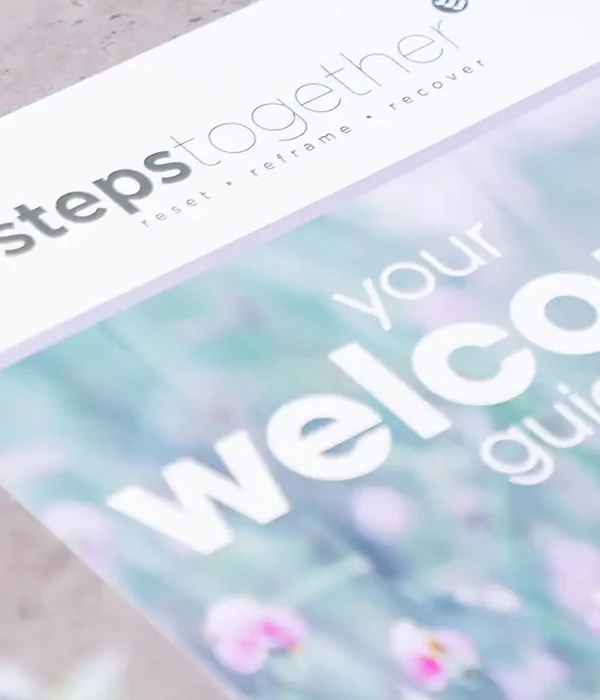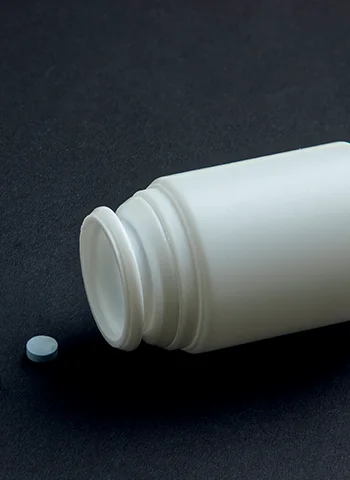Fluoxetine Addiction Treatment
If you’re searching for support or information about fluoxetine (Prozac) misuse or dependence, you’ve come to the right place. It’s normal to have questions. not only about how this medication works and what it treats, but also about what to do if its use starts to feel difficult to manage.
Fluoxetine, commonly known as Prozac, is part of a group of medicines called SSRIs that are prescribed to improve mood and emotional stability. While it isn’t usually considered addictive, some people may find themselves misusing it or relying on it in ways that cause concern.

Take the First Step Towards Recovery
Steps Together offers personalised support and proven treatments, providing the care, guidance and encouragement you need to move forward with confidence and build a healthier future.

What Is Fluoxetine?
Fluoxetine is a widely prescribed antidepressant medication that helps manage depression, anxiety, and other mental health conditions by balancing serotonin levels in the brain. As part of the selective serotonin reuptake inhibitor (SSRI) family, it is known for its effectiveness and being generally safe to use.
However, like many antidepressants, stopping fluoxetine suddenly can cause you to experience withdrawal symptoms such as mood swings or flu-like symptoms. To prevent this, it’s important to taper off the medication gradually under medical supervision.
Overview of SSRIs
SSRIs, or selective serotonin reuptake inhibitors, are among the most frequently prescribed types of antidepressants. These medicines are known for their relatively mild side effects compared to older antidepressants.
SSRIs can help treat mental health problems by boosting serotonin levels. Your health provider may start you on an SSRI because these drugs are generally well tolerated and effective for long-term use, and they shouldn’t be taken without medical advice.


Mechanism of Action
Fluoxetine works by increasing the level of serotonin, a chemical messenger in your brain that plays a key role in regulating mood, sleep, and emotions. It belongs to the class of drugs called selective serotonin reuptake inhibitors (SSRIs). These medicines block the reabsorption (reuptake) of serotonin into the neurons.
By keeping more serotonin available in your brain, fluoxetine helps improve communication between nerve cells. This effect can ease feelings of sadness, anxiety, and other symptoms of depression.
Therapies in Fluoxetine Addiction Treatment
There are a number of approaches that can be used to treat both fluoxetine addiction as well as the underlying condition, as well as the drug use itself. A treatment plan for prescription drug addiction may include:
Behavioural Therapy
Behavioural therapy helps you change unwanted behaviours tied to mental health problems. This approach encourages you to identify and manage triggers causing your drug use.
Because fluoxetine may reduce symptoms such as low mood or anxiety, you may find it easier to participate in behavioural exercises. Your therapist may give you tasks to complete at home or in social settings. These tasks aim to increase positive experiences and decrease avoidance behaviours.
Group Therapy
Group therapy connects you with others facing similar challenges. Sessions are usually led by a trained therapist and include several people. This environment encourages sharing experiences, learning from others with similar histories of substance abuse, and building social support.
If you are using fluoxetine, group therapy may help with feelings of loneliness or isolation, which are common in mental health conditions. Group exercises often focus on topics such as coping skills, healthy communication, and setting boundaries.
Individual Therapy
Individual therapy involves meeting one-on-one with a mental health professional. This setting gives you a private space to talk about personal thoughts and feelings. If you have a Prozac addiction, therapy sessions may focus on tracking your symptom changes and managing any side effects.
A key part of individual therapy is building trust so you feel comfortable discussing your struggles with drug use. Therapists may use techniques from cognitive behavioural therapy or psychodynamic therapy to help manage depression, anxiety, or compulsive behaviours. You and your therapist can decide how often you meet and set goals based on your progress.
Family Therapy
Family therapy involves you and your family working together with a therapist. The goal is to improve relationships, support, and communication. This type of therapy can be important if family issues contribute to your mental health symptoms or drug use.
Your therapist might discuss how your fluoxetine use affects not just you, but also those living with you. Family members learn about the side effects and ways to support you as you adjust to life without Prozac. This approach often helps families avoid misunderstandings and respond early to relapses or behaviour changes.
Other prescription drug addictions we treat

Uses of Prozac
Taking an antidepressant like fluoxetine is often used to treat major depressive disorder in adults and adolescents. If you are experiencing symptoms such as low mood, loss of interest in activities, sleep disturbances, and feelings of worthlessness, your doctor may suggest this medication.
It works by increasing serotonin levels, which help to regulate mood. Treatment usually starts at a low dose, with your doctor gradually adjusting it based on your response. It can also be used to treat panic disorder.
Obsessive-Compulsive Disorder and Eating Disorders
Fluoxetine is approved to treat obsessive-compulsive disorder in both adults and children aged eight years and older. If you experience obsessive thoughts and feel driven to repeat certain actions, this medication can help reduce those symptoms.
Fluoxetine is the only SSRI specifically approved for treating bulimia nervosa. Symptoms such as binge eating and purging can be extremely difficult, and fluoxetine can help reduce the frequency of binge-purge episodes. Research supports its effectiveness in decreasing both binges and purges.

Side Effects and Safety
The most common side effects include headaches, nausea, insomnia, dry mouth, and sweating. Some people may also notice dizziness, tiredness, or mild stomach problems like diarrhoea. Other side effects include sexual problems such as decreased libido, erectile dysfunction, and difficulty climaxing.
Fluoxetine misuse can lead to side effects such as agitation, confusion, nausea, dizziness, and sleep problems. In higher doses, it may cause serotonin syndrome, a potentially dangerous condition with symptoms like rapid heart rate, sweating, and tremors. Misuse can also worsen anxiety or mood swings in the short term.
Long-term use of fluoxetine can lead to effects such as emotional numbness, weight changes, and persistent sleep disturbances. Some users may also experience gastrointestinal discomfort or an increased risk of bleeding. While many tolerate it well, ongoing medical supervision is important to manage side effects and ensure continued effectiveness.
Withdrawal symptoms of fluoxetine may include dizziness, nausea, headache, fatigue, irritability, and mood swings. Some people experience sleep disturbances, anxiety, or flu-like symptoms. Though fluoxetine has a longer half-life than other SSRIs, stopping it suddenly can still cause discomfort.
Fluoxetine Addiction Rehab Options
Fluoxetine is a prescription medication used as an antidepressant and is commonly available as tablets, capsules, and a liquid form. Drug rehab options focus on managing side effects, ensuring safe use, and providing support throughout and after your prescription period.
Inpatient Rehab
Inpatient fluoxetine addiction treatment is used rarely unless you need extra support or have co-occurring mental health conditions. It involves staying at a facility where you are monitored around the clock by trained professionals.
Here, you receive structured routines, therapy, and medical management. Inpatient rehab may be considered if you are struggling with severe side effects, experiencing complex mental health crises, or have tried outpatient services without improvement.
Aftercare
Aftercare is an important step following fluoxetine addiction treatment. It aims to help you maintain progress, keep symptoms under control, and lower the chance of relapse. Aftercare may include ongoing therapy, support groups, and follow-up medical appointments.
You may continue taking fluoxetine in tablet, capsule, or liquid form for maintenance. Side effects and mental health progress should be tracked by your healthcare provider. Ongoing support increases the likelihood of long-term recovery.
Outpatient Rehab
Outpatient fluoxetine addiction treatment is more common for people on fluoxetine. It allows you to live at home while attending clinics, GP appointments, or therapy sessions. You receive support and monitoring without staying overnight at a facility.
Outpatient care focuses on helping you adjust your medication, deal with side effects, and monitor your progress in a familiar setting. Your prescription, whether for capsules or liquid, will be regularly reviewed. You also learn coping skills and take part in talking therapies. Regular check-ins and support groups may support your treatment goals.

We'll Help You Stop Taking Prozac
Medications like fluoxetine can help many people with their mental health problems. But there are instances wherein a person may be prescribed fluoxetine and experience difficulty stopping the drug due to withdrawal symptoms or psychological reliance, and it can become a mental health concern in and of itself.
But at Steps Together, we offer fluoxetine addiction treatment that can help you address not just the drug use, but the underlying conditions that required its prescription in the first place.
Frequently Asked Questions
What side effects might one experience when taking fluoxetine?
You can experience some common side effects like nausea, headaches, trouble sleeping, or feeling tired. Some people may have diarrhoea, sweating, or dry mouth. Less common effects include loss of appetite or dizziness.
For what conditions is fluoxetine typically used?
Fluoxetine is often prescribed for depression and anxiety disorders. It is also used for obsessive-compulsive disorder, bulimia nervosa, and sometimes for panic attacks. Doctors may prescribe it off-label for other conditions depending on individual needs.
What are the specific side effects of fluoxetine in females?
Females taking fluoxetine might notice changes in menstrual cycles, such as irregular periods or heavier bleeding. Some women report reduced sexual desire or pain during sex. Breast tenderness or minor changes in breast size can also occur.
At what dosages is fluoxetine commonly prescribed?
Fluoxetine is usually prescribed in doses of 20 mg daily for adults. Lower doses, such as 10 mg, are sometimes used to start, especially in young people or those more sensitive to the drug. The dose may be increased to 40 mg or even 60 mg daily, depending on the condition and your response.
How does the price of fluoxetine vary by dosage?
The price of fluoxetine tends to increase with higher dosages, but the cost difference is usually small for generic versions. Prices may also differ depending on the brand and where the prescription is filled.
Is there a difference in efficacy between 10 mg and 40 mg doses of fluoxetine?
A 10 mg dose is usually less effective for treating moderate to severe conditions compared to 40 mg. The 40 mg dose is often needed for conditions like OCD or bulimia. However, some people may respond well to lower doses, especially when starting treatment.





